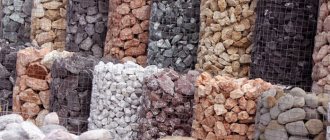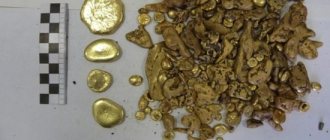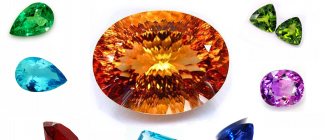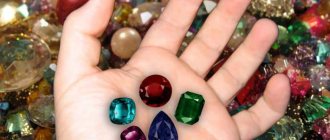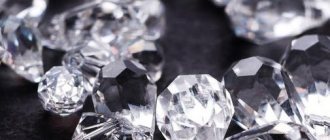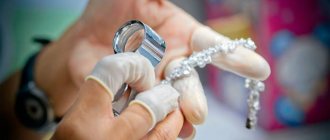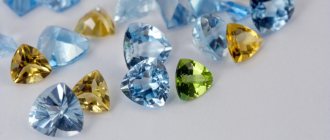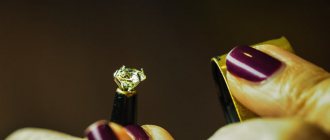Types of classifications
There is no concept of what a gemstone is. But the jewelers agreed that the nugget had three qualities: beauty, stability and rarity.
Beauty is an individual concept. The play of light, shine, color characteristics, shades are assessed. If a person wants to see them, touch them, and does not pass by, then the stone satisfies the parameter of beauty. Stability is a category of durability. A nugget is considered precious if it can withstand maximum temperatures and does not disintegrate due to impacts. Of course, in nature there are different variations of minerals, their density, cleavage, and hardness change. The mineral can withstand stable, everyday loads. What often catches the eye and is not a problem to get is not popular. The third category of natural mineral is rarity. Only those nuggets that are difficult to find and bring will be in demand and popular.
Important! Beauty, rarity and durability determine the price of stones. Secondary characteristics influence the place of extraction, type of cut, light refractive index, originality and exclusivity of color.
Alexander Fersman
Alexander Fersman is a geologist who proposed division according to mineral scales. He divided beautiful and sought-after species into categories of gems, divided by gradation of characteristics and visual attractiveness. The standard layout includes:
- 1 - diamond, sapphire and ruby;
- 2 - beryl, topaz, uvarovite, zircon, aquamarine;
- 3 - garnet, carnelian, chrysoprase, quartz, moonstone, labradorite, amethyst, hematite.
Alexander Fersman
Below are the ornamental ones shown in the first jade, lapis lazuli, labradorite. The remaining one is lepidolite, shale, steatite, halite, cyosite, and the third is brexium, gypsum, quartzite.
Fersaman's classification is completed by organogenic typologies - jet, coral, amber and pearl. Some are included twice in different branches of the scale - a major drawback. Fersman's classification was invented at the end of the 19th century, and jewelers' knowledge in the area increased. Global trends have changed - equipment has appeared on which artificial analogues of beautiful stones are made. There is no need to purchase natural ones if their substitutes are stylish, durable and beautiful. It is noticeable that minimally priced stones (third order on the scale) are now in demand and have a high price. The classification is outdated and is being replaced by Sobolevsky or Kievlenko.
Vitaly Sobolevsky
Sobolevsky's classification is based on Fersman. It appeared in 1972 and is actively used by jewelers. But it contains outdated information, so it cannot be called correct.
The highest rank species are represented in the first order by diamonds and emeralds, spinels and alexandrites, emeralds and rubies, sapphires and chrysoberyls. The second contains orange and green zircon, beryl, topaz, shades of red tourmaline, and amethysts. The third line is represented by crystal, turquoise, carnelian, jet and amber.
The first branch of the highest classifier of stones is lapis lazuli, malachite, chalcedony, labradorite, jade, and the second is marbled onyx, jasper, ophicalcite.
Evgeniy Kievlenko
E. Kievlenko
Kievlenko's development in 1973 is used in Russia and abroad. It takes into account the prevalence, uniqueness, beauty and degree of accessibility, as well as the purpose of nuggets and average market offers.
The first category of gemstones is transparent and hard. Line 1 is represented by blue sapphire, diamond, emerald and ruby. The next line is purple, orange and green sapphires, black opal and alexandrite. The third category is white and red opal, spinel, moonstone. The final type is beryl of pinkish and whitish tones, tourmalines, zircons and beryls of blue, green and red tints.
The initial line of the second type includes jade, bloodstone, rauchtopaz, lazuli, aventurine, crystal, and the lower line includes labradorite, chalcedony, agate, pink quartz, and spar.
Ornamental ones are not viewed according to the categories of purpose, type and visual appeal, cut, level of luminescence and light refraction. This is a general category represented by flint, granite, jasper, obsidian, onyx, and marble.
Changes are being made to Kievlenko's classification. Recently, alexandrite was classified as a second-class precious stone, but it already occupies a place among first-order stones. The fact is that the nugget is in demand as a natural diamond. The natural mineral is rare and has a high price.
Klug and Bauer
Kluge's typology is the oldest, appearing at the end of the 19th century. Included 5 typologies (there was no division). Bauer improved it, adding the missing elements.
The stone table starts with cut diamonds, corundum and chrysoberyl. Next comes tourmalines, opals, topazes and zircons. The third ones are turquoise, chrysolite, cordierite. The following are various quartz, chalcedony, and spar. This is the most extensive line, which includes such types of quartz as aventurine, amethyst, crystal, chalcedony, jasper, agate and carnelian, spar, labradorite, and amazonite. Also, the fourth category is supplemented with lapis lazuli and obsidian. Bronzite, jade, malazite, and hematite close the category.
Agates, lapis lazuli, malazite, and varieties of smoky quartz are considered ornamental. And organogenic ones are jets, pearls and amber.
Marking of precious minerals
Marking of jewelry with precious stones is carried out in accordance with regulations. Information about the stone is contained on the product label and on the stamp. The properties of diamonds and emeralds are described in more detail, since they largely determine the value of the jewelry. For other stones, the index that designates them is often simply indicated. List of indexes:
- 01 - diamond edge;
- 02 - cubic zirconia;
- 03 - diamond;
- 10 - amethyst;
- 20 - ruby;
- 30 - garnet;
- 40 - emerald;
- 50 - sapphire;
- 60 - pearls.
The marking of a diamond contains the following data: cut type, number of facets, carat weight, color, quality and cut group (most often in the English version). The table shows various designations for these parameters.
| Types of cuts | Cut group | ||
| Name | Designation | Processing quality | Designation |
| Round | Kr | Excellent | E (Excellent) |
| Pear | G | Very good | VG (Very Good) |
| Square | Kv | good | G (Good) |
| Marquis | M | Average | F (Fair) |
| Emerald | AND | Below the average | P (Poor) |
| Baguette | Bt | ||
| Princess | P | ||
| Triangle | T | ||
For products made in Russia, it is typical to designate the cut group with the letters A, B, C, where group A has the best value for the quality of stone processing. Diamonds are labeled to indicate the purity of the stone. In the Russian version, these are numbers from 1 to 12 (the lower the number, the purer the mineral), in other cases it is an abbreviation for the characteristics of inclusions in English.
The color of the stone is also described by numbers from 1 to 4 for small samples and from 1 to 17 for medium ones. The lower the value, the lighter the color of the diamond. For emeralds the situation is the opposite: 1 means rich dark green, 5 means pale green. The price of an emerald is influenced more by color than by purity and absence of defects.
For example, the marking 3 Kr17-0.03-1/2A on a piece of jewelry means that it contains 3 round diamonds with 17 facets, each weighing 0.03 carats. Inserts of ideal color with virtually no inclusions and high quality cutting. The disadvantage of modern marking of precious stones is the lack of information about the refinement of a natural stone or its artificial origin. For a person far from jewelry making, it is almost impossible to distinguish a synthetic mineral from a real one.
First group: jewelry (precious) stones, gems
Nuggets are divided into several types. Subtype 1-1 includes translucent variations. In particular, the types:
- 1-1-1 - maximum hardness, 10 - brilliants and rough diamonds;
- 1-1-2 - from 7 to 9 - garnet, topaz, zircon, corundum, beryl, spinel;
- 1-1-3 - from 5 to 7 - tanzanite, chrysolite, thomsonite, benitoite;
- 1-1-4 - up to 5 - zincite, flurite, scheelite.
Among the variations that do not transmit light and have a noticeable glow, subtypes 1-2-1 without a pattern (pyrite, bloodstone) and with a pattern 1-2-2 (cryptomelane, hematite) are distinguished.
There are translucent nuggets with varying degrees of color:
- 1-3-1 - with a noticeable uniform color - prehnite, carnelian, pink quartz;
- 1-3-2 - with darkening - sardonyx, hairy, agate;
- 1-3-3 - single-color - chalcedony;
- 1-3-4 - approximate - opal, moonstone.
Subgroup 1-4-1 includes options for processing - coral and turquoise, used in their natural form - pearls.
Minerals are divided according to their origin, chemical composition, and crystallographic characteristics. The most common is the crystal chemical classification of minerals (by types of chemical compounds, taking into account their structural types). Classifications of jewelry and semi-precious stones differ from mineralogical classifications primarily in that the division of precious stones is often based on their value. In Saxony at the beginning of the 19th century. According to their areas of application, precious stones were divided into precious, medicinal, and stones used in construction, for making vases, statues, etc. In the middle of the 19th century. In Europe, jewelers divided precious stones into two groups: eastern and western. This division is based on the hardness of the stone. In 1860, the German scientist K. Kluge proposed the first scientifically based classification of precious and semi-precious stones, which he divided into two groups: truly precious minerals and standard precious minerals. The first group included stones of classes I, II and III, and the second group included class IV and V stones.
K. Kluge classified diamond, corundum, chrysoberyl and spinel into class I, zircon, beryl, topaz, tourmaline, garnet, noble opal into class II, cordierite, vesuvian, chrysolite, axinite, kyanite, staurolite, andalusite, chiastolite into class III, epidote and turquoise. In the group of semi-precious stones (class IV and V), K. Kluge included the following stones: class IV - quartz (amethyst, rock crystal, rose quartz, aventurine), chalcedony (agate, carnelian, plasma, heliotrope, cacholong, jasper and ordinary hydrophane) , feldspars (adularia, amazonite, Labradorite), obsidian, lapis lazuli, hauin, hypersthene, diopside, fluorite, amber; Class V - jadeite, jade, serpentine, agalmatolite, bronzite, satin spar, marble, selenite, alabaster, malachite, pyrite, rhodochrosite, hematite, prehnite, nepheline, lepidolite, etc. The classification of precious stones by the German professor is very close to the classification of K. Kluge mineralogy by G. Gurich (1902). He combined all transparent minerals, characterized by high light refraction and used for making jewelry, into precious stones of the first kind; semi-precious stones were identified separately. Minerals that occur in an amorphous state or in the form of fine-grained crystalline aggregates are classified as a group of stones of the second type (colored stones). According to their value, G. Gurich divided precious stones into five different classes: Class I - diamond, corundum, chrysoberyl and spinel; Class II - zircon, beryl, topaz, tourmaline and garnet, as well as noble opal from the group of colored stones; Class III - cordierite, peridot, kyanite and other precious stones, in addition, turquoise from the colored group; Class IV included semiprecious stones such as quartz, feldspar, fluorite, and from the colored group - aventurine, cat's eye, chalcedony, opal, obsidian, lapis lazuli, amber; Class V includes colored stones: hematite, nepheline, jade, jet, serpentine, alabaster, malachite, etc. At the end of the 19th century. M. Bauer (1896) proposed a new classification of precious stones, which for a long time was popular among mineralogists and jewelers. M. Bauer's classification was later supplemented and expanded by A. E. Fersman. Jewelry and ornamental stones are divided into three groups: I - precious stones (gems), II - ornamental stones (colored stones), III - organogenic precious stones. Depending on the value, the stones of the group were divided into orders of magnitude. Group I included mainly transparent, colorless or beautifully colored stones and some translucent colored stones used in faceted form. Group II includes a number of minerals and rocks suitable for making cabochons and various crafts. Classification by M. Bauer - A. E. Fersman
Group I - precious stones (gems)
1st order: diamond, ruby, sapphire, emerald, alexandrite, noble spinel, euclase 2nd order: topaz, aquamarine, beryl, red tourmaline, blood amethyst, almandine, uvarovite, jadeite, noble opal, zircon 3rd order: 1 - garnet, cordierite, kyanite, epidote, dioptase, turquoise, variscite, green tourmaline;
2 - rock crystal, smoky quartz, light amethyst, chalcedony, agate, carnelian, heliotrope, chrysoprase, praseme, semi-opal; 3 - sunstone, moonstone, Labradorite, nepheline, sodalite, obsidian, titanite, benitoite, prehnite, andalusite, diopside, scapolite, thomsonite; 4 - hematite, pyrite, cassiterite, quartz with gold Group II - ornamental (colored stones)
1st order: jade, lapis lazuli, glavcolite, sodalite, amazonite, Labradorite, rhodonite, azurite, malachite, aventurine, quartzite, rock crystal, smoky quartz, agate and its varieties, jasper, vesuvian, rose quartz, written granite 2nd order: lepidolite, fuchsite slate, serpentine, agalmatolite, steatite, selenite, obsidian, marble onyx, datolite, fluorite, halite, graphite, lapis lazuli, smithsonite, zoisite 3rd order : gypsum, porphyry and partially decorative material - breccias, confluent quartzites, etc.
Group III - organogenic precious stones pearls, coral, amber, jet.
The above classification was used for a long time in the USSR and abroad.
However, it is not without a number of disadvantages; in addition, at present, the practical value of many precious stones has changed significantly, and therefore modifications of this classification have appeared [33, etc.]. In 1973, E. Ya. Kievlenko proposed a modernized classification of colored stones, which took into account their market value and use in jewelry and stone-cutting items. In 1983, this classification was refined by him [14]. Classification by B. Ya. Kievlenko First group - jewelry (precious) stones
I order: ruby, emerald, diamond, blue sapphire II order: alexandrite, orange, purple and green sapphire, noble black opal, noble jadeite III order: demantoid, spinel, noble white and fire opal, aquamarine, topaz, rhodolite, tourmaline IV order: peridot, zircon, yellow, green, pink beryl, kunzite, turquoise, amethyst, pyrope, almandine, moon and sun stone, chrysoprase, citrine The second group -
jewelry ornamental stones
I order: lapis lazuli, jadeite, jade, malachite, charoite, amber, rock crystal (smoky and colorless) II order: hematite-bloodstone, rhodonite, opaque iridescent feldspars (belomorite, etc.), iridescent obsidian, epidote - garnet and vesuvian rodingites - jades
The third group - ornamental stones
Jasper, marble onyx, obsidian, jet, petrified wood, venite leaf, patterned flint, graphic pegmatite, fluorite, aventurine quartzite, selenite, agalmatolite, colored marble, etc. For The classifications of precious stones by J. Sincancas (1955), R. Webster (1962), Suzuki and others are known abroad. Each classification is characterized by its own characteristics and differences.
In addition to the main principles underlying the classifications, there are a number of external factors - established traditions, fashion for stones, the availability of precious stones on the market, the discovery of new deposits of precious stones, etc. Therefore, individual stones in different classifications may occupy a different place, although the overall the nature of the classifications is basically the same. The development of the jewelry and stone-cutting industry in the last decade has required the creation of an industrial classification of jewelry and semi-precious stones suitable for the practical work of this new industry. This type of classification was created by the All-Union Scientific Research Institute of the Jewelry Industry (VNIIyuvelirprom). Industrial classification of natural jewelry and ornamental stones of VNIIyuvelirprom Type I. Jewelry stones
Subtype I—1.
Transparent stones: group I - 1 - 1. Hardness 10 - diamond; group I—1—2. Hardness 7-9 - corundum, beryl, tourmaline, garnet, chrysoberyl, spinel, quartz single crystals, topaz, euclase, phenacite, zircon, cordierite, andalusite, staurolite; group I—1—3. Hardness less than 7 to 5 - spodumene, chrysolite, kyanite, dioptase, brazilianite, tanzanite, chrome diopside, apatite, benitoite, axinite, scapolite, thomsonite, danburite, ulexite, cassiterite, gambergite, actinolite, green obsidian; group I—1—4. Hardness less than 5 - sphalerite, fluorite, brucite, zincite, scheelite Subtype I-2. Opaque, sparkling stones: group I—2—1. Homogeneous - hematite-bloodstone, pyrite, cobaltine, psilomelane; group I—2—2. Patterned - hematite - goethite glass head, cryptomelane - hollandite glass head Subtype I-3. Translucent stones: group I—3—1. Brightly colored stones - carnelian, chrysoprase, chloropal, rose quartz, colored semi-opals, smithsonite, prehnite, zoisite, jadeite; group I—3—2. Stones with patterns or beautiful inclusions - agate, hairstone, mosswood, onyx (sardonyx, carnelian, onyx); group I—3—3. Stones without patterns or colors - chalcedony, semi-opal, cacholong; group I—3—4. Pseudochroic stones with a certain orientation - noble opal, moonstone, iridescent obsidian Subtype I-4. Opaque matte stones with beautiful colors and dense surface texture: group I—4—1. Stones used in products with subsequent processing are turquoise, variscite, coral; group I—4—2. The stone used in its natural form is Type II pearl.
Jewelry and ornamental stones Subtype II—1.
Viscous stones, hardness more than 6: group II—1—1. Jade, jadeite and their hard natural imitations, garnet-chlorite rock, xenolith, fibrolite Subtype II—2. Stones of medium viscosity, hardness 5-6: group II-2-1. Brightly colored stones - lapis lazuli, rhodonite, amazonite, jasper, unakite (an aggregate of epidote and potassium feldspar); group II—2—2. Patterned stones - petrified wood, graphic pegmatite, patterned flint, jasper, obsidian, heliotrope, perilivte; group II—2—3. Pseudochroic stones - belomorite, falcon and tiger eye, silver (“irisating”) obsidian, aventurine, mother-of-pearl; group H—2—4. Stones used in their natural form: subgroup II—2—4a. Massive stones - buds of chalcedony, Smithsonite, jade; subgroup II—2—46. Crusts and growths - amethyst and quartz brushes, uvarovite crusts, dendrites of manganese minerals, native copper and silver Subtype II-3. Small and medium hard stones: group II—3—1. Cold processed: malachite, azurite, serpentine, anthracite Type III.
Precious stones Subtype III—1. Hardness more than 5: group III-1 - 1. Glassy - obsidians, jaspers, hornfels, microquartzites, ferruginous hornfels; group III—1—2. Heterogeneous rocks and mineral aggregates: subgroup III-1-2a. Ice quartz, taganay quartzite, amazonite granite; subgroup III—1—26. Peridotites, pyroxenites, hedenbergite skarn; subgroup III—1—2c. Listvenite, jaspilite; subgroup III—1—2g. Eclogite, garnet gneiss, tourmaline-containing rocks; subgroup III—1—2d. Granitoids, nepheline syenites, labradorite, porphyries, etc. - Subtype III-2. Hardness from 5 to 3: group III—2—1. Translucent - aragonite and calcite onyx, fluorite; group III—2—2. Opaque - marbles, ophiocalcite, anhydrite, serpentine, chlorite-serpentine rock Subtype III-3. Soft, hardness less than 3: group III—3—1. Translucent - alabaster, selenite, halite; group III—3—2. Opaque - graphite, soapstone, pyrophyllite, brucite, steatite. There are industrial-genetic, technological, trade and other classifications. The choice of one or another classification is determined by the tasks of the gemologist.
In this work, the description of jewelry stones is given according to the taxonomy already used by the authors in their works. All jewelry stones (about 200 items) are divided into three groups: I - jewelry stones of inorganic origin (minerals and, to a lesser extent, rocks), II - jewelry stones of organic origin, III - synthetic jewelry stones. Group I is the most extensive. It is advisable to systematize the minerals in it according to the only stable characteristic - crystal chemical (used by many other gemologists), because the division into precious, semi-precious, orders of magnitude in accordance with cost and other types is very arbitrary for most stones. It, as already noted, depends on market conditions, fashion, traditions, quality and color of the same stone, the discovery of new deposits, the emergence of synthetic analogues and many other reasons. In the first, rather large, group of jewelry stones, if necessary, two subgroups can be distinguished: traditional and non-traditional jewelry stones. Traditional jewelry stones have long been widely used in jewelry. These include: diamond, ruby, sapphire, emerald, aquamarine, chrysoberyl, alexandrite, opal, pyrope, almandine, spessartine, demantoid, hessonite, spinel, topaz, tourmaline, Labradorite, moon and sun stone, zircon, peridot, turquoise, kunzite , amethyst, citrine, rose quartz, aventurine, chrysoprase, carnelian and other varieties of quartz and chalcedony, lapis lazuli, jadeite, jade, malachite, etc. In different countries, their significance and value in different eras and years was different. The most expensive (precious) have always been diamond, emerald, ruby and sapphire. They form the basis of state currency funds, they are used as investments, the price of these stones is not affected by artificially grown analogues. The cost of the rest may experience significant fluctuations in time and space. The subgroup of non-traditional jewelry stones is also very heterogeneous. Several orders can be distinguished in it. The first order includes new jewelry stones. These are relatively recently discovered minerals or varieties of well-known minerals that have found recognition primarily as jewelry: benitoite, brazilianite, hydrogrossular (Transvaal jade), californite (vesuvianite), clinohumite, singalite, tapheite, tanzanite, tsavorite, chrome diopside, charoit and some others. The second order includes jewelry varieties of minerals, known mainly as rock-forming, collectible, or having raw material value. Currently, they are used as independent jewelry stones, less often - as imitations of well-known jewelry stones and sometimes form significant accumulations (deposits). These are hauin, herderite, dumortierite, eremeyevite, lazulite, purpurite, scapolite, sodalite, staurolite, tugtupite, phenakite, fluorite, ceruleite, eudialyte, euclase, enstatite, epidote, etc. The third order includes mainly varieties of minerals that have beautiful color, transparency, asterism effects, cat's eye, etc., which are mainly collection samples that have ever been used in jewelry as independent jewelry stones or, more often, as imitation of some expensive stones. In the early 80s. In this century, yellow transparent titanite has appeared in large quantities on the jewelry stone market, which, thanks to its strong diamond luster and very high dispersion of refractive indices (0.051), very successfully imitates diamonds. The cost of natural imitation not only exceeded the cost of the best synthetic imitations (cubic zirconia, fabulite, etc.), but also the cost of some traditional jewelry stones of the same color (beryl, citrine, grossular, zircon, etc.). Faceted titanite weighing from 1 to 5 carats cost up to $150/carat (1980, USA). The cost of stones of this order is the most unstable and can not only increase sharply, but also fall. Such stones include apatite, azurite, andalusite, wollastonite, gambergite, hemimorphite, danburite, datolite, dioptase, cancrinite, cassiterite, nepheline (eleolite), pollucite, sillimanite, smithsonite, sphalerite, titanite, celestite and others. Division into orders and even into subgroups in the taxonomy proposed by the authors is not something frozen, because new jewelry stones can become traditional over time; when significant accumulations of third-order jewelry stones are found, they will move to the second, and vice versa - when deposits are depleted, second-order stones will move to III. Jewelry stones of organic origin (group II) were identified by Academician A.E. Fersman. This group of stones includes pearls (natural and cultured), coral, amber and other natural resins, jet, bones, horns and tusks of various animals (elephant, mammoth, rhinoceros, walrus, etc.), turtle shell, mother of pearl. Odontolite (“bone turquoise”) can also be included in this group. III group of jewelry stones - synthetic stones. These stones were created by the genius of man, his desire to comprehend and repeat the processes of nature. In many cases, people created a complete analogue of natural stones, but despite this, their cost in most cases was many times lower. At the same time, man created new unique jewelry stones (cubic zirconia, fabulite, etc.). Therefore, the authors also divide group III into subgroups. The first includes synthetic jewelry stones - analogues of natural jewelry stones: diamond, corundum, spinel, quartz, opal, alexandrite, emerald, spodumene, malachite, turquoise; the second - synthetic jewelry stones that have no natural analogues: cubic zirconia, yttrium oxide, yttrium-aluminum garnet (YAG), gadolinium-gallium garnet (GGG), strontium titanate (fabulite), lithium niobate, barium and sodium niobate, lithium tantalate and etc.; the third - synthetic stones that have natural non-jewelry analogues and are used mainly as imitation of traditional jewelry stones: moissonite, bromellite, periclase, rutile, cassiterite, zincite, scheelite, etc.; the fourth is a group of materials that have names similar to traditional jewelry stones, but do not correspond to them in composition, structure or properties: turquoise, lapis lazuli, coral, etc. The group of synthetic jewelry stones will expand over time due to the intensive development of the synthesis of more and more minerals.
Second group: jewelry and ornamental stones, colored stones
Semi-precious class is not second-class stones, as is commonly thought. This is a separate segment, which is determined by the average hardness of the mineral. Subtype 2-1 includes variations with hardness up to 6 on the Mohs scale. This is fibrolite, jade, xenolith. With a viscosity of 5 to 6, minerals are divided into:
- having a strong, uniform color - jasper, lapis lazuli, rhodonite;
- with a pattern - obsidian, fossilized rock, graphite, gelotrope;
- with dichroic coloring - aventurine and tiger's eye;
- with a natural color that does not change during processing - chips of amethyst and quartz, copper, jade and chalcedony buds.
Separately, the third subcategory of jewelry and ornamental stones includes those stones that are processed at minimum temperatures. These include serpentine, malachite and anthracite.
Klug and Bauer classifications
K. Kluge, a German mineral scientist, in 1860 proposed a system dividing minerals into five groups. He classified the first three as truly precious stones (diamond, topaz, chrysoberyl, spinel, beryl, opal, corundum, zircon, garnet, tourmaline), and the last two as standard ones (hematite, jadeite, malachite, etc.). In 1898, Brouwer proposed the following classification: precious, ornamental, and also distinguished gems of organic origin (this group included corals, pearls, jet and amber). Each of the groups was divided into subgroups by category, i.e. were assigned to a certain order.
Third group: ornamental stones
The value, in comparison with the first group, is small. Their hardness indicators slightly exceed 5 points, but more often do not reach this indicator. Among relatively hard materials (more than 5 on the Mohs scale), glassy and heterogeneous ones are distinguished. If the former are represented only by jaspers, hornfels and obsidians, then the latter are divided into additional categories:
- icy quartz;
- peridotites;
- listvenite;
- eclogite;
- granitoid.
The middle group is a hardness from 3 to 5 points. Transparent variations (fluorite, onyx) and matte (marble, serpentine) are noted.
Reference. The least valuable, but sold, are ornamental stones with a hardness of up to 3 points. Translucent variations are halioma and alabaster, and non-translucent variations are brucite and graphite.
Nugget classifications help jewelers quickly determine the price of a mineral. They take into account the appearance, external characteristics, place of extraction, hardness, size, uniqueness of color, originality of natural ornament, level of radiance. Depending on the deposit, weight, cut and shade of the nugget, the price per carat can fluctuate hundreds or even thousands of times.
Origin of the word "gem"
This term is not a strict definition of a single group. Initially, this was the name given to transparent minerals; later, this term began to mean opaque or pre-cut stones. The designation is of Russian origin. It was first mentioned by the Russian writer and art critic Mikhail Pylyaev, after visiting the Urals in the mid-19th century during his cultural expedition. The name consists of two words “self” and “colored”. However, in those days, almost all ornamental stones distinguished by their beauty were called this way.
gems from left to right rock crystal, citrine, quartz, moss agate
Let's sum it up
The information provided with available approaches to the classification of natural gems can help to quickly determine its value by name, but one must always remember that the range of categories by which it is necessary to evaluate it is very wide and it is not enough to focus only on whether the gem belongs to a certain species or class.
Thus, it is quite difficult to classify natural precious stones, because in order to classify a mineral as precious, many criteria must be taken into account. The most reliable method of evaluation, therefore, is still subjective, because it is impossible to determine the value of a gem based only on the data of which group it belongs to.
